Renogy DC to AC Power Inverter R-INVT-PUH1-101235 User Guide
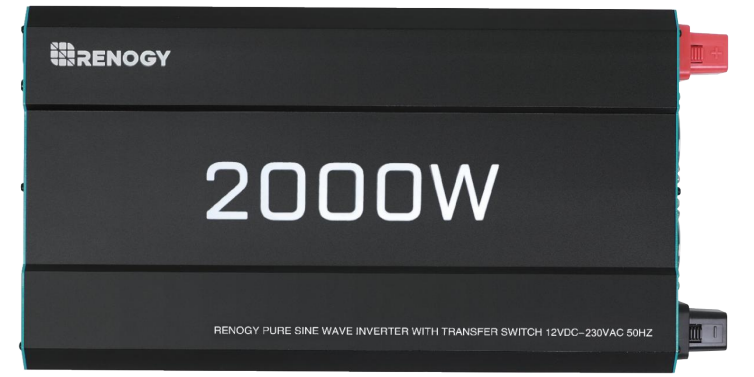
Content
DC to AC Power Inverter R-INVT-PUH1-101235 Introduction
The R-INVT-PUH1-101235 is a DC to AC power inverter designed to convert direct current (DC) into alternating current (AC) at specified voltages and frequencies, making it suitable for various applications such as home appliances and renewable energy systems. The cost of the R-INVT-PUH1-101235 inverter is approximately $150. This inverter employs advanced switching technologies, ensuring efficient power conversion and stability.
Specifications
| Item Number | R-INVT-PUH1-101235 |
|---|---|
| Rated Input DC Voltage | 12VDC |
| Constant Output Power | 1000W |
| Output Voltage | 220-240Vac |
| Output Frequency | 50HZ |
| Static Current | 1.0A |
| Input Voltage Range | 11-16VDC |
| Low Voltage Shutdown | 10VDC |
| Recover from Low Voltage Protection | 12VDC |
| Rated AC Input Voltage Range | 200-240VAC |
| Rated AC Input Current | 100A |
| Transfer from Battery Supply to AC Mains | Within 50mS |
| Transfer from AC Mains Supply to Battery | Within 50mS |
| High Voltage Shutdown | 16.3VDC |
| Ambient Temperature | 0°C - 40°C |
| Heat Dissipation | Fan |
| Ingress Protection | IP20 |
| Product Dimension | 34217376 mm |
| Weight | 2.6kg |
Important Safety Information
Incorrect installation or misuse of the inverter may result in danger to the user or hazardous conditions. We urge you to pay special attention to all CAUTION and WARNING statements. CAUTION statements identify conditions or practices that may result in damage to other equipment. WARNING statements identify conditions that may result in personal injury or loss of life.
DANGER
HAZARDOUS OF ELECTRIC SHOCK EXPLOSION OR ARC FLASH This equipment must only be installed and serviced by qualified electrical personnel.
- Always use a properly rated voltage sensing device to confirm power is off.
- Replace all devices, doors, and covers before turning on power to this equipment.
- batteries can present a risk of electric shock, high short-circuit current and exposure gases and chemicals.
- The following precautions must be observed when working with batteries.
- Remove watches, rings or other metal objects.
- Use tools with insulated handles.
- Do not lay tools or other metal parts on top of batteries. Servicing of batteries must only be performed by qualified personnel knowledgeable of batteries and the required precautions. Keep unqualified personnel away from batteries.
- Disconnect the charging source prior to connecting or
- Note that the surface temperature of the product is too high to prevent burns. disconnecting battery terminals.
- Failure to follow these instructions will result in death or serious injury.
The inverter is a compact and highly portable power inverter, the leader in the field of high frequency inverter design. From the dedicated 12V DC battery, or the solar power bank, the inverter will efficiently and reliably power a wide variety of household AC products such as TVs, computers and VCRs. The included automatic safety monitoring circuitry protects the inverter and battery from inadvertent errors.
Read this guide before installing or using the inverter and save it for future reference.
Safety Features
These advanced safety features are built into the inverter:
- Electronic overload protection with automatic shutdown.
- Built-in internal backup DC fuse provides added safety.
- Low battery voltage protection with automatic shutdown.
- Over temperature protection with automatic shutdown.
- Output short circuit protection.
Installation Guidelines
Selecting a Suitable Location
For safe and optimum performance, install the inverter in a location that is .....
- Dry. Do not expose to water drip or spray.
- Cool. Operate only in ambient temperatures between 32 F (0 C )and 104 F (40 C). Keep away from furnace heating vents or other heat producing equipment.
- Well ventilated. Allow at least 2 inches (5cm) clearance above and on all sides of the unit for proper cooling.
- Safe. Do not install inverter in a compartment with batteries or flammable liquids, such as gasoline, or explosive vapors.
- Clean and free of dust and dirt. This is especially important if the inverter is used in a work environment.
- Elevation. The product is installed and used at an altitude of less than 2,000 m.
- Avoid side and top foreign material from falling inside the device.
- Use only sealed lead-acid, flooded, lithium battery, or gel batteries which must be deep cycle.
Products must be installed by qualified electricians. The product must be installed in a dry and well-ventilated area, as close as possible to the battery. A space refrigeration device of at least 10 centimeters should be left.
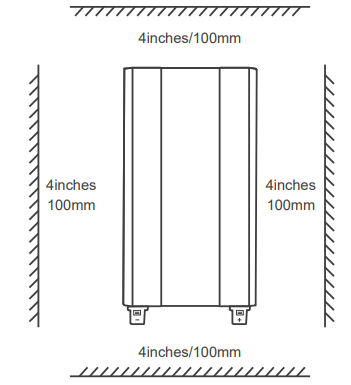
Please Note: While the inverter has fans for cooling, this installation location optimal for natural convection cooling will improve the overall efficiency.
Using the DC Cable-Ring terminal
Due to limitations in the common 12V DC outlet in a vehicle or boat, the inverter should only be used to supply AC power to products that require the rated continuous power or less.
- Attach the ring type connector marked with red to the positive (+) DC terminal on the inverter and attach the ring connector marked with black to the negative (-) DC terminal.
CAUTION
A reverse polarity connection (positive to negative) may damage the inverter. Damage caused by a reverse polarity connection is not covered under warranty. - Tighten the nut on each DC terminal by hand until it is snug. Do not over tighten.Products must be installed by qualified electricians. The product must be installed in a dry and well-ventilated area, as close as possible to the battery. A space refrigeration device of at least 10 centimeters should be left.Installation Guidelines
Selecting a Suitable Location
For safe and optimum performance, install the inverter in a location that is .....
- Dry. Do not expose to water drip or spray.
- Cool. Operate only in ambient temperatures between 32 F (0 C )and 104 F (40 C). Keep away from furnace heating vents or other heat producing equipment.
- Well ventilated. Allow at least 2 inches (5cm) clearance above and on all sides of the unit for proper cooling.
- Safe. Do not install inverter in a compartment with batteries or flammable liquids, such as gasoline, or explosive vapors.
- Clean and free of dust and dirt. This is especially important if the inverter is used in a work environment.
- Elevation. The product is installed and used at an altitude of less than 2,000 m.
- Avoid side and top foreign material from falling inside the device.
- Use only sealed lead-acid, flooded, lithium battery, or gel batteries which must be deep cycle.
Using the inverter
The inverter is capable of continuously powering most 230V and 240V AC products that use the rated continuous output power or less. The inverter is a pure sine wave and is designed to mimic utility power. The power, or "wattage", rating of ac products is the average power they use. When many AC products are first switched on, they initially consume more power than their power rating.
TVs, monitors, and electric motors are examples of products that have high "surge" requirements at start up. Although the inverter can supply momentary surge power as high as surge power, occasionally some products rated less than the rated continuous output power may exceed its surge capabilities and trigger its safety overload shutdown feature.
If this problem occurs when attempting to operate several AC products at the same time, try first switching on inverter with all AC products switched off ,then one by one switch each on, starting with the high surge product first.
- Indicators and Controls (See Figure 1)
- The AC outlets are provided on one end of the inverter. Any combination of 230V/240V AC product with a total continuous power consumption of the continuous power or less may be plugged in.
- The ON/OFF switch enables output AC power at the AC outlets when switched ON.
- The green POWER light indicates AC power is present at the AC outlets and the inverter is operating normally.
- The red FAULT light indicates inverter shutdown caused by low or high voltage, overload or excessive temperature.
- The yellow Fault light indicates short circuit or overload starting protection
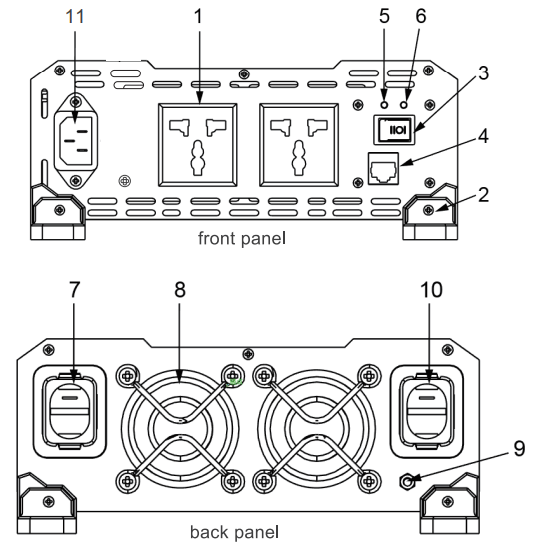
- AC outlet socket
- Fixed foot
- ON/OFF switch
- Remote port
- Fault indicator
- Power indicator
- Black (negative) terminal M8
- Fan
- Ground terminal
- Red (positive) terminal M8
- AC input (Pin socket 10A)
Socket Types

Package Contents
| Package Contents | |
|---|---|
| DC TO AC POWER INVERTER × 1 | User Manual × 1 |
| Wired Remote Control × 1 | |
| 1000W: 20mm² @ 600mm | |
| 2000W: 20mm² @ 600mm | |
| 3000W: 25mm² @ 600mm |
Inverter operation
- When properly connected to a 12V DC outlet or battery, turning the ON/OFF switch ON, will illuminate the green POWER light, and AC power to the outlets.
- Plug the AC products) you wish to operate onto the AC outlets) and switch them on, one at a time.
- As the battery capacity is used up, battery voltage begins to fall. When the inverter senses that the voltage at its DC input has dropped to 9.7~10.7V, the audible alarm will sound. This allows time for computers or other sensitive devices to be shut down.
- If the audible alarm is ignored the inverter will automatically shut down when the battery voltage drops to 9~10V. This prevents battery damage from excessive discharge. After auto shut down, the red FAULT light illuminates.
On the DC (M8) side, remove the protection cap.

Unscrew Positive and Negative DC Input Terminals, connect a battery bank to the terminals, and tight the terminal screws. Torque: 14(#0.5) N-m
For your safety, it is recommended to use a battery fuse.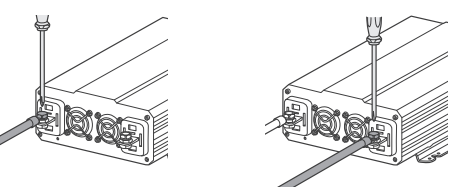
Model: R-INVT-PUH1-101235
Continuous Output Power: 1000W
Battery Fuse: 150A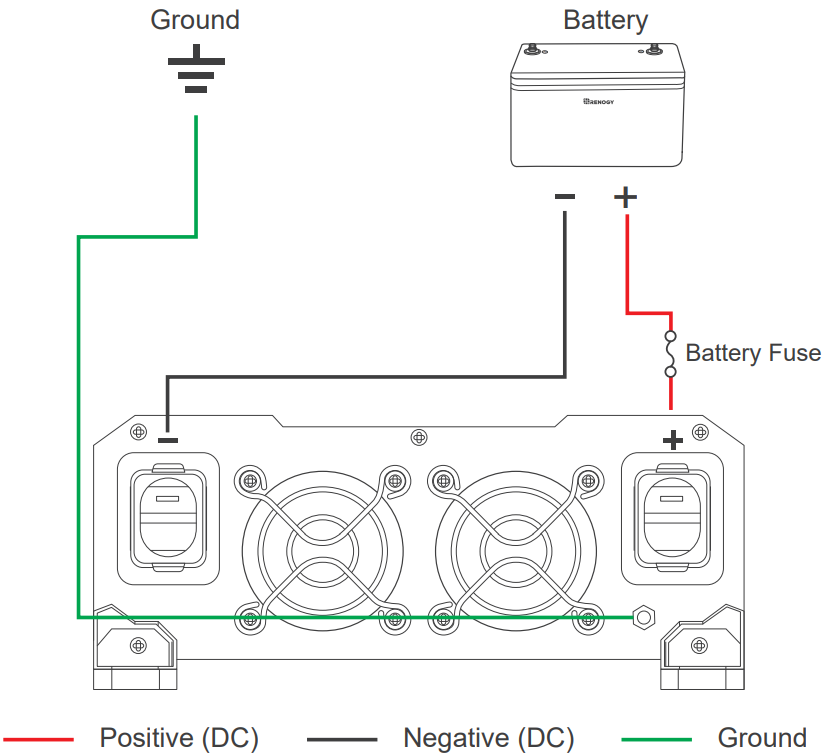
IMPORTANT: Vehicle batteries are designed to provide short periods of very high current needed for engine starting. They are not intended for constant deep discharge. Regularly operating the inverter shortens the life of the battery. Consider connecting the inverter to a separate deep discharge type battery if you will be frequently running electrical products for long time.
Tip: The user uses the attached wire.
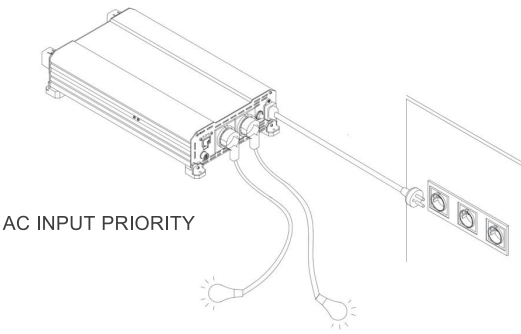
- AC Priority function: when both AC input and battery input available
- You can plug your AC loads directly into the receptacles on the inverter's AC side. (PE connec- tors cannot be used for other purposes)
- AC input is selected automatically as priority.
- When AC input being removed, the unit will change to DC input automatically.
- Connect the AC input cable set with the plug on the inverter panel, connect the load and switch on inverter.
- If an AC product rated higher than the rated continuous power (or which draws excessive surge power) is connected, the inverter will shut down. The red FAULT light will turn on.
- If the inverter exceeds a safe operating temperature, due to insufficient ventilation or a high temperature environment, it will automatically shut down. The red FAULT light will turn on and the audio warning will sound.
Should a defective battery charging system cause the battery voltage to rise to dangerously high levels, the inverter automatically shuts down.

CAUTION: Although the inverter incorporates protection against over-voltage, it may still be damaged if the input voltage exceeds 16 volts.
Description
The Renogy DC to AC Power Inverter R-INVT-PUH1-101235 is built with high-quality components to ensure long-lasting performance. The pure sine wave output makes it suitable for sensitive electronics such as laptops, medical equipment, and televisions. The inverter features multiple protection mechanisms, including overload, short circuit, and overheat protection, ensuring safe operation under various conditions. Its compact and lightweight design makes it easy to integrate into any setup, whether it's a home backup system or an RV electrical system.
Battery Operating Time
- Operating time will vary depending on the charge level of the battery, its capacity and the power level drawn by the particular AC load.
- When using the battery of the vehicle as a power source, it is strongly recommended to start the vehicle every hour or two to recharge the battery before its capacity drops too low. The inverter can operate while the engine is running, but the normal voltage drop that occurs during starting may trigger the inverter's low voltage shut down feature.
- Because the inverter draws less than the no-load current draw with the ON/OFF switch in ON position and with no AC products connected, it has minimal impact on battery operating times.
Interference with Electronic Equipment
Generally, most AC products operate with the inverter just as they would with household ACpower. Below is information concerning two possible exceptions.
Buzzing Sound in Audio Systems and Radios
Some inexpensive stereo systems, "boom boxes", and AM-FM radios have inadequate internal power supply filtering and "buzz" slightly when powered by the inverter. Generally, the only solution is an audio product with a higher quality filter.
Television Interference
The inverter is shielded to minimize its interference with TV signal. However, with weak TV signals interference may be visible in the form of lines scrolling across the screen. The following should minimize or eliminate the problem:
- Use an extension cord to increase the distance between the inverter and the TV, antenna and cables.
- Adjust the orientation of the inverter, television, antenna and cables.
- Maximize TV signal strength by using a better antenna and use shielded antenna cable where possible.
- Try a different TV. Different models of televisions vary considerably in their susceptibility to inverter.
AC Priority Switch Function
- When AC utility power available and inverter is connected, the internal circuit will detect and change from battery mode to AC utility mode. When AC utility power is not available, the internal circuit will detect and change back to battery supply mode.
- After the transfer from battery supply to AC utility supply or from AC utility supply to battery supply, please check if the electronic devices need to be restarted manually.
Setup Guide
To operate the Renogy DC to AC Power Inverter R-INVT-PUH1-101235, follow these steps:
- Connect the inverter to your DC power source (batteries or solar panels) using the provided cables.
- Ensure all connections are secure and tightened properly.
- Turn on the inverter by pressing the power button.
- Plug your AC appliances into the inverter's AC outlets.
- Monitor the inverter's display for any error messages or warnings.
Troubleshooting
PROBLEM: AC product will not operate.
| Possible Cause | Suggested Solution |
|---|---|
| Battery is defective. | Check battery and replace if required. |
| Inverter has been connected with reverse DC input polarity. | Check connection to battery. Probable inverter damage has occurred. Have unit repaired (not covered by warranty). |
| Loose cable connections. | Check cables and connections. Tighten as required. |
PROBLEM: Inverter will run some small loads. but not large ones.
| Possible Cause | Suggested Solution |
|---|---|
| Voltage drop across DC cables | Shorten cables or use heavier cables. |
PROBLEM: Battery run time is less than expected.
| Possible Cause | Suggested Solution |
|---|---|
| AC product power consumption is higher than rate. | Use a larger battery to make up for increased power requirement. |
| Battery is old or defective. | Replace battery. |
| Battery is not being properly charged. 1 | Many simple charges are unable to charge a battery fully. Replace charger with 2 a better model such as a TRUE CHARGE smart charger. |
| Power dissipation in DC cables. | Use shorter/heavier DC cables. |
PROBLEM: Battery run time is less than expected.
| Possible Cause | Suggested Solution |
|---|---|
| AC product(s) connected are rated at more than the rated continuous output power; overload shutdown has occurred. | Use product with a power rating less than the rated continuous output power. |
| AC product is rated less than rated continuous output power; high starting surge has caused overload shutdown. | Product exceeds inverter's surge capability. Use a product with starting surge power within the inverter's capability. 1 |
| Inverter has overheated due to poor ventilation and has caused over temperature shutdown. | Switch inverter OFF and allow to cool for 15 minutes. Clear blocked fan or remove objects covering unit, Locate unit to a cooler environment, Reduce load if continuous operation is required. Restart. Verify charging system is properly regulated and battery is 12V2 DC nominal. |
Pros & Cons
Pros:
- Pure sine wave output suitable for sensitive electronics.
- High efficiency up to 90%.
- Multiple protection mechanisms for safe operation.
- Compact and lightweight design for easy installation.
- Affordable pricing compared to similar products.
Cons:
- Limited to 1000W continuous power, which may not be sufficient for high-load applications.
- No built-in battery charger or MPPT controller.
- Some users report issues with customer support.
Customer Reviews
Customers generally praise the Renogy DC to AC Power Inverter R-INVT-PUH1-101235 for its reliability and efficiency. Many users appreciate its pure sine wave output, which allows them to run sensitive electronics without any issues. However, some users have reported minor issues with customer support and the need for additional components like a battery charger or MPPT controller.
- "I've been using this inverter in my RV for several months now, and it has performed flawlessly. The pure sine wave output is perfect for my laptop and other electronics." - John D.
- "The only drawback is that it doesn't come with a built-in battery charger. However, the price is very reasonable considering its quality and performance." - Sarah K.
Faqs
What is the input voltage range of the AC Power Inverter?
What type of waveform does this inverter produce?
Does this inverter have built-in overload protection?
How do I know if the inverter is overheating?
Can I use this inverter in extreme temperatures?
Does the inverter come with cables and connectors?
How long does it take to set up the inverter?
Is there a warranty on this product?
Can I use this inverter for medical equipment?
Leave a Comment
